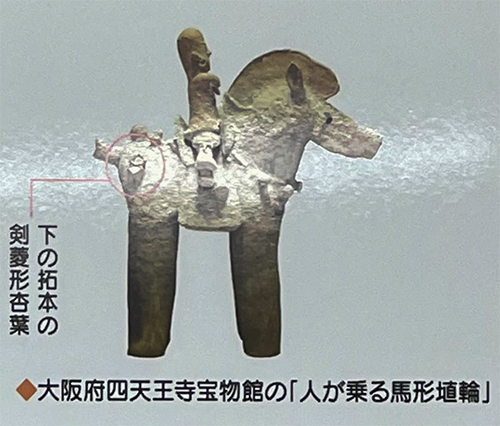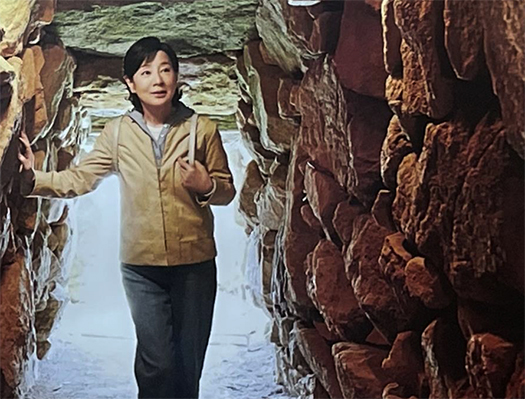


始原期のヤマト王権の状況をうかがい知るような取材として
奈良盆地での纏向や飛鳥での動きの探訪と、引き続いての
板東での王権勢力の伸張事例としての上毛野氏を見てきた。
中央政権による地方統治はどういう根拠に依るべきか、
日本の王権は必ずしも方法論を持っていなかったことが見える。
5-6世紀には地方権力に対し中央と同一の前方後円墳築造許可という
アイコンを下賜したけれど、そういう威信付与だけでは
中央政権への服従、全国支配の実質は担保されなかった。
527年の筑紫国国造・磐井の乱、534年の武蔵国造の乱など、
地方に展開した豪族にして見れば、中央政権への服従には
合理的根拠がなかったと思われ非服従の姿勢が顕著になった。
放っておけば、朝鮮半島と同様に統一王朝は実現しなかっただろう。
結局、各地域バラバラ八百万という出雲の轍を踏んだのではないか。
そういう統一国家形成の最大の規定要因とは
仏教という思想での統一、支配論理の一貫性確保と
先進的政治思想としての「律令体制」の導入だったのだろう。
東アジア全域でこういう方法論は模索され、
最終的には628年、唐という律令国家出現が画期となったが日本では
先に仏教思想導入があって「篤く三宝を敬え」政策があった。
ヤマト王権内部での蘇我氏と物部氏の対立とは
この統一国家成立原理への相克対立だったのだと思われる。
そして結局は蘇我氏が勝利して、一円的に仏教思想が列島を覆った。
鎮護国家と律令体制という結論に古代国家は行き着いた。
しかし結局、公地公民という「社会主義」思想では経済発展は望めず
10世紀に至って統一政策は破綻していくことになる。
この中央と地域豪族との相克関係は、日本史の骨格的対立軸として
最終的には武権による暴力装置支配が趨勢になっていく。
この上毛野氏の遺跡を見る限り、
前方後円墳による統一国家アイデンティティ段階の地方権力と思える。
上毛野氏は地方豪族であると同時に中央権力機構の有力者でもあった。
だから、朝鮮半島への派遣軍の副司令官をも担った。
一方経済的には、国家管理だったと思われる鉄器生産技術、農業土木技術が
墾田永代私財法の成立が象徴するように各地域で私有地が拡大し
その「一所懸命」が権力の分散型のありようを誘発。
やがて板東の自立支配構造、武家政権へと連なっていく流れを生んだ。
その過程で日本には一所懸命の「個人主義」的思想が根付いた。
剥き出しの土地争奪戦はわかりやすい個人主義を涵養したと思う。
他方、大陸国家は日本と比較して地域社会が多様すぎて
その統一維持には専制的独裁が優勢になった。
東アジアで日本だけが民主主義の社会基盤を持つ結果を生んだ。
English version⬇
The Formation of the Relationship between the Center and the Regions of the Japanese Nation: An Exploration of the “Kamitukeno Clan”-7
The historical centrifugal force between Japan, where the uniqueness of each region prevailed in the process of establishing a unified nation, and China, where only a dictatorship that suppressed uniqueness was possible. …
In order to get a glimpse of the Yamato kingdom in the primitive period, we will
We have looked at the movements in the Nara Basin in Makimuku and Asuka, and at the Kamitukeno clan as an example of the expansion of the royal power in Bando.
I have looked at the Kamitukeno clan as an example of the expansion of the royal power in Bando.
On what basis should local rule by a central government be based?
The Japanese kingship did not always have a methodology.
In the 5th and 6th centuries, local authorities were given the same icon of permission to build the same anterior and posterior mounds as the central government.
But such a grant of prestige alone was not enough.
However, such a grant of prestige alone was not enough to ensure submission to the central government and nationwide domination.
The rebellions of the Tsukushi Kokuzo and Iwai in 527 and the Musashi Kokuzo rebellion in 534, for example, were not enough to ensure submission to the central government and nationwide rule.
The local powerful clans that had developed in the provinces would not have had a rational basis for obedience to the central government.
The local powerful clans, who had developed in the provinces, were thought to have had no rational basis for obeying the central government, and their attitude of disobedience became pronounced.
If left unchecked, a unified dynasty would not have been realized, as was the case on the Korean peninsula.
In the end, they may have followed the Izumo rut of eight million people from different regions.
The biggest determinants of the formation of such a unified nation were
The unification of the country through the ideology of Buddhism, ensuring consistency in the logic of rule, and
and the introduction of the Ritsuryo system as an advanced political ideology.
This methodology was explored throughout East Asia, and was finally adopted by the Tang Dynasty in 628.
The final turning point was the emergence of the Tang Dynasty in 628, but in Japan, the introduction of Buddhist thought
In Japan, the introduction of Buddhist thought was preceded by the policy of “reverence for the three treasures.
The conflict between the Soga and Mononobe clans within the Yamato kingdom
The conflict between the Soga and Mononobe clans within the Yamato kingdom is thought to have been a conflict over the principle of establishing a unified state.
In the end, the Soga clan won the battle, and Buddhist thought covered the whole archipelago in a circle.
The ancient state arrived at the conclusion of the Chingo-no-Kokoku and the Ritsuryo system.
In the end, however, the “socialist” idea of “public land and public citizenship” did not lead to economic development.
The unification policy collapsed in the 10th century.
This conflict between the central government and the local powerful clans has remained the backbone of Japanese history.
The final trend was for the military power to rule with a violent apparatus.
The ruins of the Kamitukeno clan show that the unified state of the Kamitukeno clan was based on the use of anterior posterior circular mounds.
The Kamitukeno clan seems to be a local power at the stage of unified national identity through the use of an antero-posterior burial mound.
The Kamitukeno were not only a local clan, but also a powerful member of the central power structure.
Therefore, he was also the deputy commander of the army dispatched to the Korean peninsula.
On the other hand, economically speaking, iron production technology and agricultural engineering technology, which are thought to have been under the control of the state, were developed by the Kamitukeno.
As symbolized by the enactment of the Kenta Eien Private Property Law, private property expanded in each region, and the “hard work” was dispersed through the dispersion of power.
This “hard work” triggered a decentralized form of power.
This “single-mindedness” triggered a decentralization of power, which eventually led to the Bando’s independent ruling structure and the samurai government.
In the process, the idea of “individualism” took root in Japan.
I believe that the bare land struggle fostered an easy-to-understand individualism.
On the other hand, the local communities in the continental countries were too diverse compared to those in Japan.
In order to maintain their unity, despotic dictatorships prevailed.
Japan is the only country in East Asia with a democratic social base.
Posted on 8月 15th, 2022 by 三木 奎吾
Filed under: 日本社会・文化研究, 歴史探訪







コメントを投稿
「※誹謗中傷や、悪意のある書き込み、営利目的などのコメントを防ぐために、投稿された全てのコメントは一時的に保留されますのでご了承ください。」
You must be logged in to post a comment.